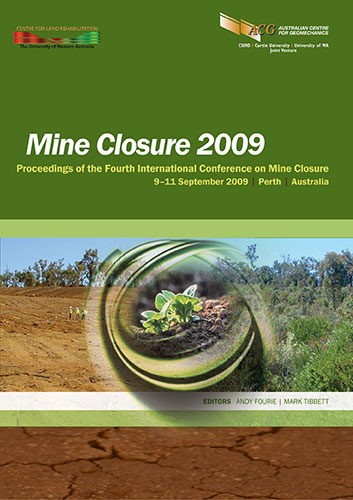Management of mine sites after closure

|
Authors: Bocking, KA; Kam, SN; Welch, DE; Williams, DA |
DOI https://doi.org/10.36487/ACG_repo/908_17
Cite As:
Bocking, KA, Kam, SN, Welch, DE & Williams, DA 2009, 'Management of mine sites after closure', in AB Fourie & M Tibbett (eds), Mine Closure 2009: Proceedings of the Fourth International Conference on Mine Closure, Australian Centre for Geomechanics, Perth, pp. 245-252, https://doi.org/10.36487/ACG_repo/908_17
Abstract:
The ideal outcome for mine closure measures is a walk-away scenario, with all hazards and liabilities resolved and with the land returned to beneficial use. Unfortunately, in the majority of cases, this ideal is not practicably attainable. After a mining company makes large capital expenditures and completes its agreed closure measures, it may still have ongoing obligations, liabilities and risks. These could include: post- closure inspections and reporting, routine care and maintenance, and in some cases, ongoing treatment of effluent. In addition, there may also be residual hazards to the public, safety concerns related to, for example, unstable crown pillars or open pit slopes as well as a risk of failures due to long return period events, such as floods and earthquakes. Uncertainties will also remain regarding the performance of the long-term closure measures. There may also be unresolved liabilities requiring financial reporting and costs associated with ongoing beneficial use of the land. If, alternatively, the mining lease is returned to the government, there may be a requirement for a lump sum payment to cover future costs associated with the unresolved liabilities. It is possible to estimate the aggregate cost of these unresolved post-closure liabilities using risk modelling. The risk cost could then form the basis for the following alternative approaches for managing mining properties after closure: • Retaining the property and establishing internal funding to pay for future costs and risks. • Returning the mining lease to the government, with a payment to cover the future costs and residual risks. • Transferring the ownership to a special purpose company and purchasing insurance against the residual liabilities on the property. • Transferring some of the assets to a local community or government with some arrangement to cover costs of future maintenance and risks.
References:
Carter, T.G. and Miller, R.I. (1995) Crown Pillar Risk Assessment – Cost Effective Measures for Mine Closure
Remediation Planning, Transactions of the Institute of Materials, Minerals and Mining (UK), Maney Publishing,
Leeds, UK, Vol. 104, pp. A41–A57.
Fitzgerald, P.T. (2006) Mine Risk and Closure Strategies – Risk Financing Solutions for Environmental Liabilities and
Sustainability, Purves Redmond Limited, Toronto, Canada, (unpublished paper).
Welch, D., Payne, R., Balins, J. and Kam, S. (1997) The Closure of the Quirke Uranium Tailings Basin, A Case Study,
Golder Associates Ltd., Mississauga, Canada, (unpublished paper).
© Copyright 2025, Australian Centre for Geomechanics (ACG), The University of Western Australia. All rights reserved.
View copyright/legal information
Please direct any queries or error reports to repository-acg@uwa.edu.au
View copyright/legal information
Please direct any queries or error reports to repository-acg@uwa.edu.au